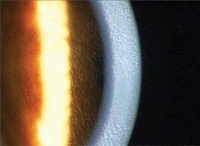 Q: I’ve heard that the number of PRK procedures has increased in the past few years. What has spurred this change?
Q: I’ve heard that the number of PRK procedures has increased in the past few years. What has spurred this change?
A: PRK volume is gaining on LASIK, comparatively speaking. “PRK continues to go up as LASIK continues to go down,” says Richard Duffey, M.D., of Mobile, Ala., in Review of Ophthalmology.1 This is according to the results of an annual survey, co-developed by Dr. Duffey, of members of the American Society of Cataract and Refractive Surgery.
In terms of total volume, LASIK still accounts for three-fourths of refractive procedures, while PRK accounts for one-fourth. “However, as LASIK has continued to drop, and the overall numbers continue to decrease, the proportion of PRK cases is actually going up,” Dr. Duffey says. “I think this is a result of a conservative movement that makes us more willing to do PRK if we have any doubt about the risk of ectasia or any other problems.”
Indeed, the survey found that the reported cases of ectasia have remained flat recently. From a biomechanical viewpoint, PRK may be a less invasive surgical approach for the correction of myopia than LASIK, a recent study found.2
Optometrist Brian Den Beste, founder of Lasik Pro Vision Consultants, in Orlando, Fla., says this is one of several reasons for the resurgence in PRK procedures. “Doctors are realizing that the ectasia that can occur [in LASIK] is not easy to treat, and occurs less when the cornea is not significantly thinned [as in PRK],” Dr. Den Beste says.

Diffuse lamellar keratitis (DLK), as shown here, can be avoided with PRK.
Other reasons for the increase in PRK:
• No DLK. “You can’t get diffuse lamellar keratitis (DLK) when performing PRK,” he says. “DLK can be devastating, and is something that occurs pretty easily if certain precautions are not adhered to.”
• No epithelial ingrowth. “You can’t get epithelial ingrowth when performing PRK. A less common and less serious complication than DLK, but still annoying,” he says.
• Comparable acuity. “PRK is a very simple procedure to perform, and data in several studies have shown essentially equal acuity at the three-month post-op visit when compared to LASIK,” Dr. Den Beste says.
• Affordability. Last but not least: the economy. “LASIK is an elective procedure, and patients have obviously chosen to put off anything that is not required during this time when the U.S. economy is struggling,” he says. “PRK is less expensive than LASIK to perform. Whether a keratome or a femtolaser is used to create the flap, both incur more expense for the laser center, which of course is passed on to the patient.”
Q: Has post-op management of PRK improved, and how does this affect the optometrist’s comanagement of the patient?
A: “Post-op pain has always been the Achilles’ heel of the procedure,” Dr. Den Beste says. “Quieting inflammation is critical to comfort. So, our protocol includes a bandage contact lens and prednisolone acetate, which is key. We prescribe it at least q.i.d., but encourage patients to use it up to every two hours in the first three days.”
In Dr. Den Beste’s center, PRK patients are also given the sleeping medication Ambien (zolpidem tartrate, Sanofi-Aventis), “which is safer and works better than narcotic pain medicine,” he says.
PRK patients aren’t seen on day one, but get a phone call at home. “Comanagement visits include day three, one week, and then mandatory monthly IOP checks as steroid responders do exist,” Dr. Den Beste says. “Patients are typically kept on topical steroids for two to three months, depending on the healing process and the amount of laser applied.”
1. Bethke W. Survey proves flatlines aren’t always bad. Rev Ophth. 2009 June;16(6):76-7.
2. Kamiya K, Shimizu K, Ohmoto F. Comparison of the changes in corneal biomechanical properties after photorefractive keratectomy and laser in situ keratomileusis. Cornea. 2009 Aug;28(7):765-9.

